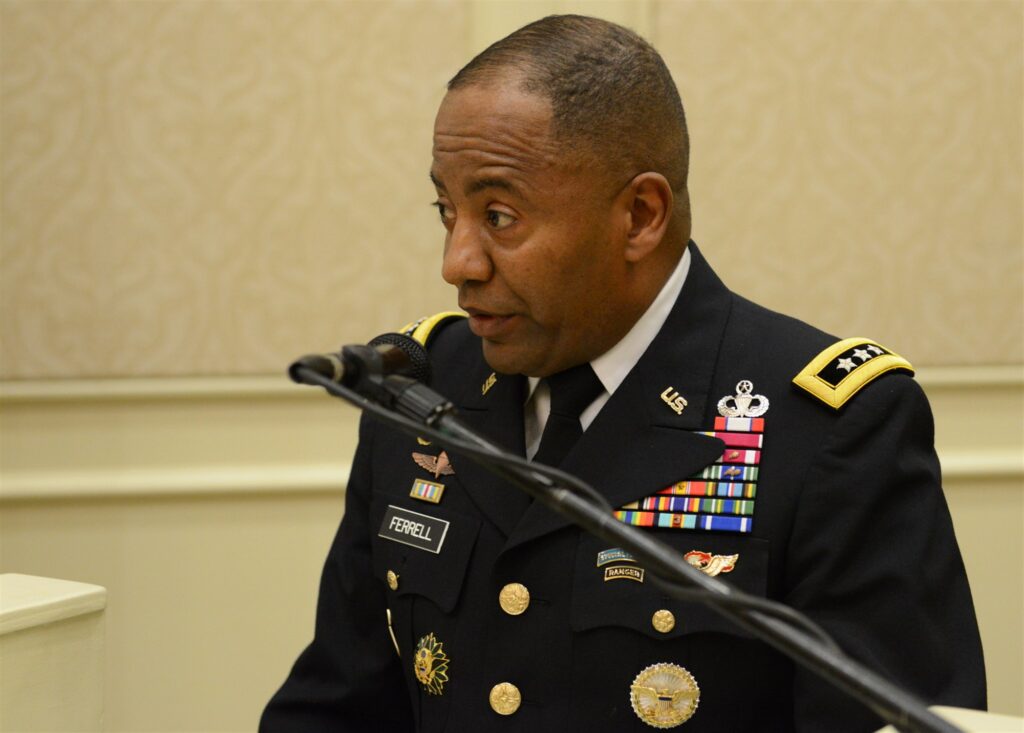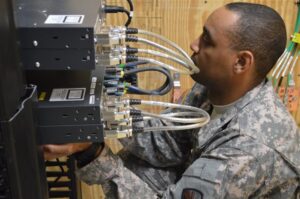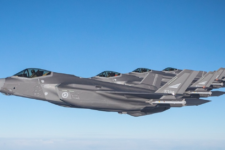
Lt. Gen. Robert Ferrell
ARLINGTON: The digital dam has burst. It took the Army three grueling years to set up a new, more secure network at its first site in San Antonio, which went live in fall 2014. Now a dozen more installations have gotten the upgrade, exulted the Army CIO this morning, and another 20 will go live before 2018.
Upgrading a single base is an effort equivalent to switching an entire city from, say, Comcast to Verizon, Lt. Gen. Robert Ferrell told an Association of the US Army conference here. But with San Antonio showing the way, he said, “our network modernization effort (has) really taken off at light speed.”
As of today, “we have actually migrated 13 installations” in the United States and abroad, Ferrell said. “By the end of this year, we should achieve about 19 installations. By the end of next (fiscal year), we will achieve 34 installations that have migrated to JRSS and then upgraded capacity.”

An Army technician helps install Joint Regional Security Stack (JRSS) components at Joint Base San Antonio – Fort Houston
JRSS stands for Joint Regional Security Stack, which in turn is part of a broader effort — not a formal program — called the Joint Information Environment or JIE. The concept is to consolidate literally hundreds of separate and often incompatible, Army networks, each with different security standards and its own vulnerable connection to the public Internet, into a couple dozen well-defended enclaves worldwide. Working with the Defense Information Systems Agency, the Army and Air Force are leading the way on JRSS, followed by the Navy and Marine Corps, whose systems are more secure and in less urgent need of upgrades.
Europe is now top priority, with stateside bases second. (One wonders whether the threat of Russian hackers is behind this choice).
“As we speak, we actually are migrating EUCOM (European Command) headquarters,” Ferrell said. “By the second quarter of next year, we should have Europe completed with the migration, and then we’ll focus on CONUS (the Continental United States.”
Not that the stateside effort is standing still. The Army Reserve has moved over to the new network, Ferrell said, the Army National Guard will follow, and then the Army Corps of Engineers will come after that. Army Materiel Command (AMC), Installation Management Command (IMCOM), Army Test & Evaluation Command (ATEC), and Network Command (NETCOM) are all “in dialogue” about getting upgraded, he added.
The wave of upgrades involves not only installing JRSS for security but closing down small, under-used data centers and transferring their data to centralized repositories. There’s a lot of inefficiency in the current system: In recent “mini-pilot” at Redstone Arsenal, Ferrell told reporters, bringing in some commercial services “cut their operating costs in half instantly.” The potential savings have the Army looking hard at the cloud.
“The next effort is really cloud, and my intent is to create a hybrid portfolio for the Army, to allow units to select where they would like to store their data — not everything is going to move to the cloud,” Ferrell said. He wants to offer commanders three options with different levels of security: privately operated cloud services where the data is stored off-base, private sector data centers on base, and government-run DISA MilCloud datacenters.
The Army plans a three-year pilot program for cloud services at Redstone Arsenal, home of the massive Army Materiel Command, which currently has about two dozen data centers. Industry proposals are due by July 19th, and the Army expects to make an award in September.
This fall, the Army will also release a Request For Proposals (RFP) to replace its old, expensive-to-sustain hardwired phone networks with software-defined “soft client” systems providing both voice and video as a “unified capability.” This effort should give Army soldiers and civilians “all the capabilities that you have on the iPhone,” Ferrell told reporters, untethering them from their desks.
The Army will have regular computers for a long time, however, and Ferrell acknowledged it will take years to upgrade them all to the Windows 10 operating system — something the Defense Department ordered the services to do by early 2017. “We will not meet that requirement,” Ferrell said. “There’s a lot of work involved to get the Army to that … It will be at least a one to two, maybe a three-year journey.”
“We’re moving very fast (to Windows 10) on the enterprise side” at installations in both the US and Europe, Ferrell said. On the tactical side, however, the Army is still figuring out which weapons systems have which version of Windows embedded, which will determine the no-doubt-hefty cost.
Meanwhile, the Army announced that Army Cyber Command (ARCYBER) would be officially elevated to an Army Service Component Command (ASCC). The bureaucratic move empowers the relatively young command all the authorities enjoyed by longstanding ASCCs as Army Special Operations Command or US Army Europe.
Out of INF, Army deploys Typhon weapon to the Philippines
“This is a significant step in our partnership with the Philippines, our oldest treaty ally in the region,” said Brig. Gen. Bernard Harrington, commanding general of the 1st MDTF.


























